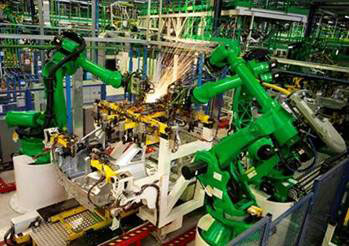Manufacturing data is proliferating, but a massive amount is siloed and untapped. DataOps is the key to connecting the dots to gain value.

Manufacturing trails behind other sectors when it comes to harnessing data management through DataOps. Image: Seagate Technology
By Jeffrey D. Nygaard, Executive Vice President and Head of Operations, Products, and Technology at Seagate Technology
The global manufacturing sector is huge. It generates about $10 trillion in revenue worldwide—and about 20% of that in the United States alone. While COVID-19 has affected manufacturing, the outlook for industry is strong.
It’s clear that manufacturing’s future is inextricably linked to products. It is less obvious that it also depends on the data management that supports production.
Indeed, there is a disconnect between manufacturers’ deep investments in factory equipment and software—and the neglected need for unified data views in manufacturing . By using mass data operations (DataOps) to make sense of data, other industries gain competitive advantage. According to the new Rethink Data report from Seagate Technology based on an IDC study of 1,500 enterprise leaders worldwide, manufacturing trails behind other sectors when it comes to harnessing data management through DataOps—the discipline of connecting data creators with data consumers. The gaps between factory floors and data consumers need filling in.
As part of production processes, manufacturers are dealing with a deluge of data. They must leverage advanced analytics, machine learning (ML), and artificial intelligence (AI) not only to make their products—but also to boost business results through data management. To do that, manufacturers need to ensure a unified view of data.
IDC’s 2018 IT/OT Convergence Survey found that nearly 80% of instrumented production assets are digitally connected in some form. That’s good news.
But why isn’t the rapid growth of digital assets accompanied by a more wide-reaching data management in manufacturing? Why do manufacturing data silos still exist? Data should be put to use with the help of data-management software, hardware, orchestration, and processes.
The Rethink Data report shows that manufacturing data has been growing slower than in other industries: 37% vs. 42.2%, on average. Manufacturing trails other industries in hybrid cloud and multicloud adoption for primary workloads. Industry leaders report data storage management as their greatest challenge. Somewhat surprisingly for a sector known for AI and ML implementation, manufacturing shows the lowest level of task automation in data management and lowest rate for full integration of data management functions.
The reason for this is fourfold:
One, legacy burdens persist. Manufacturing technologies change fast; it can be hard for data management to keep up with the variety of sensors on various machines on factory floors. In many cases, aging infrastructure can’t keep up with the amount of connected assets entering the plant. Too often plants implement ad hoc processes to connect and manage assets without an underlying infrastructure for comprehensive management.
Two, there’s also an IT-related skill-set gap among the sector’s workforce. If skilled workers represent manufacturing’s future in developed economies, the lack of adequate skills is one of the toughest barriers that companies need to address. They are dealing with aging workforces and challenges in finding new skilled employees willing to work on the plant floor.
Three, the shift of some data toward the edge complicates things. Rapid data growth for manufacturers is linked to the growth of IoT devices at the edge of their data networks. Edge devices are disconnected from headquarters systems—and big data transfers over corporate networks are expensive and slow.
Four, manufacturers need comprehensive data management software. Manufacturing customers are dissatisfied with the data-management software tools for views of their overall business. And many factories lack data management software. There is little support for virtualization software to display and find the patterns in the data across multiple departments.
The situation in manufacturing didn’t occur overnight.
“Early on, the push was to connect industrial machines together via the [IoT] and let machine-to-machine communications drive insights and automation,” per an account from the MIT Sloan. “However, the complexity of plant floor data and a lack of clarity around goals hobbled a lot of early efforts, according to Matt Wells, vice president of digital product management for GE Digital and a presenter on the EmTech panel.”
Some manufacturing companies have taken the lead in leveraging predictive data analytics to improve overall efficiency and performance.
One such company is Robert Bosch GmBH, the German auto-components manufacturer. Bosch’s Homburg Rexroth manufacturing plant, which produces hydraulic valves for trucks or tractors, uses wireless communication and radio-frequency identification (RFID) tags to connect workers, machines, and parts. The result is a more efficient production process. The plant’s single assembly line can make 200 different versions of hydraulic valves—becoming more versatile in its output—while reducing manufacturing costs and its consumption of electricity.
Another company taking advantage of more streamlined data analytics is Caterpillar, the Chicago-based manufacturer of big construction and harvesting equipment. Caterpillar, based in Peoria, Illinois, is using predictive analytics, based on data from its factories, to improve customer services and business outcomes, liberating data from silos.
“Information like fuel sample analysis, fill bucket weight, idle time, fuel consumption—all these different things we capture within all these connected machines give us this large amount of data,” said Jeff Krupp, director of applications at Cat Digital. “We can throw that data into predictive analytics models that are going to ensure we’re driving a customized experience, making our machines more productive and, therefore, making our customers more productive.”
To survive digital disruption, manufacturers who want to keep winning should join the ranks of Bosch and Caterpillar.
The five steps for better data management in manufacturing include:
But—and this is key—don’t just leave communication about data to the machines. Conversations about data should not be relegated to the CIOs, data scientists, and the IT department. Business owners ought to encourage cross-company insights about the usefulness of various types of data—and subsequent classification of data according to what they want it to accomplish.
Successful DataOps is not just about technology. It’s about communication regarding data that, along with efficient analytics, helps establish a single pane of glass view of the information that holds great business value.

Jeff Nygaard
Jeffrey D. Nygaard, Executive Vice President and Head of Operations, Products, and Technology at Seagate Technology
Leading a global organization, Jeff Nygaard manages over 38,000 people who speak nine languages and live on three continents. He first started working at Seagate as an engineer. During his tenure, he has been instrumental in building high-performance teams, integrating a competitor’s business, developing strategic alliances, and restructuring Seagate. Nygaard reflects the senior management team’s philosophy that a holistic, responsible business—one that treats people, the environment, and our community with respect—enables better results.
Recently, Nygaard served twice as the president of the American Chamber of Commerce in Thailand. He holds Bachelor’s and Master’s degrees in Mechanical Engineering from the University of Minnesota, with a focus on Robotics and Control System Design. He is a certified Six Sigma Master Black Belt. He lives in Thailand with his wife and two children.
In this episode, I sat down with Beejan Giga, Director | Partner and Caleb Emerson, Senior Results Manager at Carpedia International. We discussed the insights behind their recent Industry Today article, “Thinking Three Moves Ahead” and together we explored how manufacturers can plan more strategically, align with their suppliers, and build the operational discipline needed to support intentional, sustainable growth. It was a conversation packed with practical perspectives on navigating a fast-changing industry landscape.